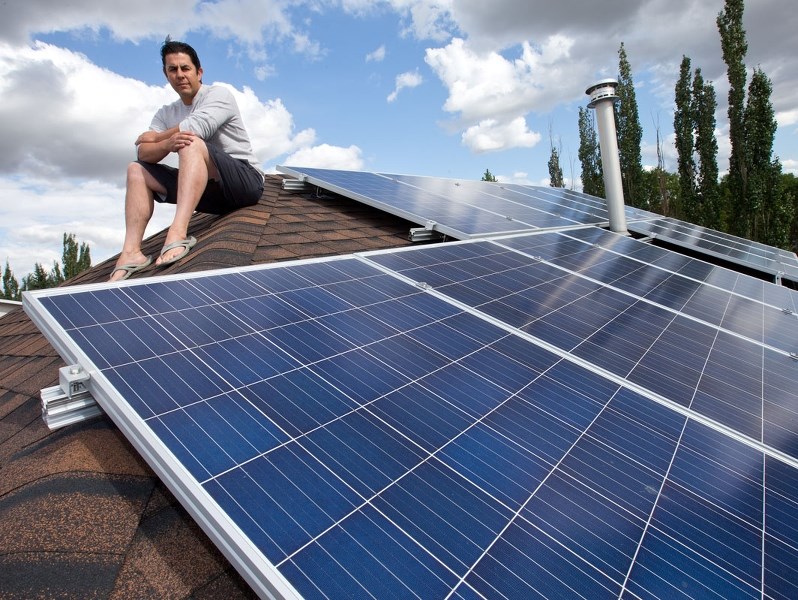By Kevin Ma
Dave Pearson has one of the shiniest roofs in St. Albert.
Pearson installs solar modules for a living, and put about 34 of them up on his Evergreen Close roof two months ago, transforming it into a giant mirror.
"You've gotta kind of practise what you preach," he explained.
Frustrated by all the fees charged by the electricity companies, Pearson said he wanted to use solar to get rid of his power bill and promote his business.
His rooftop array now pumps up to 8.5 kilowatts of free power into the power grid every hour, making it likely the biggest domestic array in St. Albert. He's still paying transmission fees, but he's also producing about four times more power than he's actually using.
"I'm 99.9 per cent certain I won't be paying a power bill."
Benefits of solar
Pearson is one of a growing number of people who are going solar by putting photovoltaic modules on their property.
There are about 1,100 grid-tied solar systems in Alberta and 301 in Edmonton, says Gordon Howell, an electrical engineer with the Solar Energy Society of Alberta who's worked with the solar technology for 35 years.
The Alberta Climate Change Advisory Panel reports that electricity is the second biggest source of greenhouse gas emissions in Alberta after the oil and gas industry.
Solar modules use the photoelectric effect to convert light into energy, Howell said. That energy then goes into your house, displacing energy from the grid.
"That is immediately reducing the amount of carbon being put into the atmosphere on your behalf," he said, as well as many other forms of pollution.
A 6 kW system will cover the average homeowner's annual power needs (7,200 kWh/year), Howell says. Through some convoluted calculations, he estimates that such a system would offset about 4.4 tonnes of emissions each year.
It would also earn you money. Sign up to be a micro-generator – which requires completion of a short form – and the province will pay you market rates for the power you generate, Howell said. It works out to about $0.08/kWh.
Ron Simonsmeier spent nothing on electricity last month at Alberco Construction thanks to the 216-module array on the roof of his Riel Industrial Park office. The array produces enough power to energize his business and his electric car and makes him $800 a month.
"They (the power company) owe me 46 cents, I think."
Getting solar
Solar can cost a lot up front: about $3 per watt, or about $18,000 for a 6 kW system, Howell said. Based on the current price of power and many other factors, he estimates that such a system will pay for itself in about 18 years.
Pearson says he took out $20,000 on his line of credit to install his system, and estimates that it'll pay for itself in about 10 years.
Simonsmeier is leasing his system through the Enmax Home Solar program and estimates he'll have the system paid off in about 20 years – sooner if electricity prices go up. He said it's similar it to an investment with a five per cent annual return.
If you don't have the specialized structural, electrical and solar engineering knowledge needed to install a solar system, Howell said you should probably hire someone who does. The Alberta Solar Energy Society's website lists many solar providers who will help you install a solar system.
The modules you get should at the very least be CSA-approved, Howell said. The really good ones will have the IEC 61215 certification, which means they've met international standards for hail, temperatures and humidity. Check the phone book for a list of local suppliers.
You'll need about 38 square metres of space for a 6 kW system, Howell said. Ideally, you'll put it on a shade-free south-facing roof to catch the most sun. It's best to mount the modules at 60 degrees so the snow slides off, but they still work if you lay them flat on the roof.
Howell said a regular solar system requires virtually no maintenance, although you have to replace the inverter and modules after 20 and 75 years (respectively). You can push the snow off it in the winter if you like, but that's not really necessary.
Solar makes great sense for any business owner and most homeowners, Simonsmeier says.
"If your roof is facing the right way, I think it's worth it."
It also looks neat, Pearson said.
"I think it looks sharp, myself."
Carbon Tracker
Step: Install a solar PV system.
Difficulty: Tough.
Cost: About $3 per watt, or $18,000 for the average 6 kW system.
Payback Period: About 18 years.
Carbon Saved: 4.4 tonnes per year for a 6 kW system.
Note: payback and carbon based on some really complex calculations.
The Carbon Challenge
Climate change is happening, and it's being driven in most part due to our carbon emissions. Our carbon challenge is to reduce those emissions so that the climate of tomorrow is better than the one we have today. <br />The Carbon Challenge will profile different ways you can shrink your carbon footprint and (usually) save money every second week. <br />Got a carbon question? Drop me a line at [email protected].




